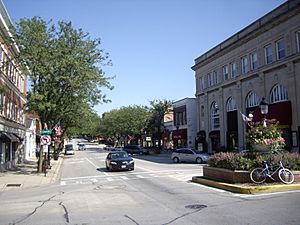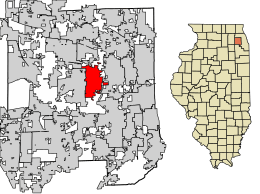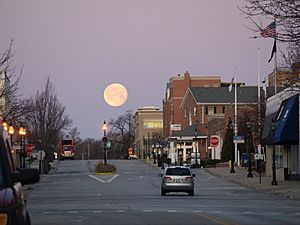Glen Ellyn, Illinois facts for kids
Quick facts for kids
Glen Ellyn
|
||
|---|---|---|
|
Village
|
||
| Village of Glen Ellyn | ||

Glen Ellyn Main Street
|
||
|
||
| Motto(s):
"Village of Volunteers"
|
||

Location of Glen Ellyn in DuPage County, Illinois.
|
||
| Country | ||
| State | Illinois | |
| County | DuPage | |
| Township | Milton | |
| Settled | 1834 | |
| Incorporated | May 10, 1896 | |
| Government | ||
| • Type | Council–manager | |
| Area | ||
| • Total | 7.05 sq mi (18.26 km2) | |
| • Land | 6.89 sq mi (17.84 km2) | |
| • Water | 0.16 sq mi (0.42 km2) 2.36% | |
| Population
(2020)
|
||
| • Total | 28,846 | |
| • Density | 4,187.26/sq mi (1,616.73/km2) | |
| Up 1.7% from 2000 | ||
| Standard of living | ||
| • Per capita income | $39,783 (median: $74,846) | |
| • Home value | $292,930 (median: $278,000 (2000)) | |
| ZIP Codes |
60137, 60820, and 60821
|
|
| Area codes | 630 and 331 | |
| Geocode | 29756 | |
| FIPS code | 17-29756 | |
Glen Ellyn is a village in DuPage County, Illinois, United States. It's a suburb located about 24 miles (39 km) west of downtown Chicago. In 2020, about 28,846 people lived there.
Contents
The Story of Glen Ellyn
Glen Ellyn has a long history, starting with early settlers. It's similar to the nearby town of Lombard.
Early Settlers and Fish's Corners
In 1833, two brothers, Morgan and Ralph Babcock, from New York, claimed land here. They settled near a large forest and the DuPage River. Their neighbor, Winslow Churchill, joined them in 1834 with his family. This first settlement was called Babcock's Grove. It included parts of what are now Glen Ellyn and Lombard.
In 1835, Daniel Fish built a cabin at a five-cornered intersection west of the river. More settlers soon followed him. By the 1840s, this area was known as Fish's Corners. It had a general store, a blacksmith shop, and a Baptist church.
Stacy's Tavern and the Railroad
Moses Stacy, a soldier from the War of 1812, arrived in 1835. He built a house south of Fish's Corners. In 1846, Stacy built an inn called Stacy's Tavern at the five corners. This inn was a halfway point for travelers between Chicago and the Fox River Valley. It was also a stop for stagecoaches heading to Rockford. Today, Stacy's Tavern is a historical monument. You can find it at the corner of Geneva Road and Main Street.
In 1849, the Galena and Chicago Union Railroad was built through Glen Ellyn. The railway was about a mile south of Fish's Corners. At first, trains didn't stop there. A local landowner, Lewey Quitterfield Newton, made a deal with the railroad. He offered land for the tracks and built a depot and water tank. In return, the railroad agreed to make trains stop. This new depot became Newton Station. The town's center then moved closer to the station.
How Glen Ellyn Got Its Name
The growing settlement had many names over the years. These included Babcock's Grove, DuPage Center, Stacy's Corners, and Newton's Station. It was also called Danby, after a local landowner's birthplace in Vermont. Later, it was named Prospect Park.
The name Glen Ellyn was chosen by 1889. It combines "glen," which means a narrow valley, with "Ellyn." This part of the name comes from the Welsh version of the name of village president Thomas E. Hill's wife, Ellen.
Growth and Changes Over Time
In 1889, President Hill and businessman Philo Stacy worked together. They created a new lake, called Lake Glen Ellyn, by building a dam. Today, this lake is known as Lake Ellyn.
In 1890, people found mineral springs near the village. This helped Glen Ellyn become known as a health resort and Chicago's newest suburb. The Village of Glen Ellyn was officially formed on May 10, 1892. That same year, a large hotel, the Lake Glen Ellyn Hotel, opened. Sadly, much of the business area was destroyed by fire that year. Fourteen years later, the hotel was struck by lightning and burned down.
Glen Ellyn's fire department started in 1907. It was made up entirely of volunteers. For a long time, it was the only all-volunteer fire department in DuPage County. By World War I, the Glen Oak Country Club was serving the communities. In 1922, the first Glenbard high school was built. The name "Glenbard" combines "Glen Ellyn" and "Lombard."
Where is Glen Ellyn?
Glen Ellyn is a suburb of Chicago. It is located about 24 miles (39 km) directly west of downtown Chicago.
Location and Size
Glen Ellyn covers a total area of about 7.01 square miles (18.16 km2). Most of this area, about 6.85 square miles (17.74 km2), is land. The rest, about 0.16 square miles (0.41 km2), is water.
People of Glen Ellyn
Glen Ellyn has grown quite a bit over the years. In 1890, there were 473 people. By 2020, the population had grown to 28,846.
| Historical population | |||
|---|---|---|---|
| Census | Pop. | %± | |
| 1890 | 473 | — | |
| 1900 | 793 | 67.7% | |
| 1910 | 1,763 | 122.3% | |
| 1920 | 2,851 | 61.7% | |
| 1930 | 7,680 | 169.4% | |
| 1940 | 8,055 | 4.9% | |
| 1950 | 9,524 | 18.2% | |
| 1960 | 15,972 | 67.7% | |
| 1970 | 21,909 | 37.2% | |
| 1980 | 23,691 | 8.1% | |
| 1990 | 24,944 | 5.3% | |
| 2000 | 26,999 | 8.2% | |
| 2010 | 27,450 | 1.7% | |
| 2020 | 28,846 | 5.1% | |
| U.S. Decennial Census | |||
In 2020, there were 28,846 people living in Glen Ellyn. About 34.5% of households had children under 18. Most households, about 61.55%, were married couples. The average household had about 3 people.
The median age in the village was 41.0 years. About 26.6% of the population was under 18. The median income for a household was $118,208. For families, the median income was $169,358.
Working in Glen Ellyn
Glen Ellyn has several large employers. These companies and organizations provide many jobs for the community.
The top employers in Glen Ellyn are:
| # | Employer | # of Employees |
|---|---|---|
| 1 | College of DuPage | 3837 |
| 2 | School District 41 | 549 |
| 3 | School District 87 | 485 |
| 4 | Village of Glen Ellyn | 460 |
| 5 | Duly Health and Care | 275 |
Getting Around Glen Ellyn
Glen Ellyn has several ways to get around.
Train and Bus Travel
The Metra Union Pacific West Line serves Glen Ellyn. The Glen Ellyn station is in the downtown area. It is about 22.4 miles (36.0 km) from the Ogilvie Transportation Center in Chicago.
Pace buses also serve the village. Routes 714, 715, and 301 pass through Glen Ellyn on Roosevelt Road.
Trails and Roads
The Illinois Prairie Path is a bicycle trail that goes through the village. The Great Western Trail (Illinois) also passes through the northern part of Glen Ellyn.
At the east end of the village, Roosevelt Road connects to Interstate 355. This makes it easy to travel by car.
Fun and Recreation
The Glen Ellyn Park District was created in 1919. It provides many fun activities for the community. These include sports, dance, and childcare. The park district offers over 700 programs all year long.
Parks and Facilities
The park district maintains 30 parks for the community. These parks are used for recreation and events like youth football. There are also two lakes, including Lake Ellyn.
The district has several recreation buildings. These include the Ackerman Sports & Fitness Center and the Lake Ellyn Boathouse.
Special Events
The park district organizes many events. The Taste of Glen Ellyn is a popular way to start the summer. On the Fourth of July, there's a firework show at Lake Ellyn. There is also a Fourth of July parade through downtown Glen Ellyn.
Ackerman Sports Center
The Ackerman Sports Center is a large indoor facility. It has an indoor track, a field house, and an indoor turf soccer field. There's also a rock climbing wall and a fitness center. It offers many activities for both kids and adults.
Spring Avenue Recreation Center
The Spring Avenue Recreation Center, or "SARC," is a main facility for the park district. It has a fitness center, dance studios, and a gymnastics area. The SARC also hosts meetings for the Glen Ellyn Park District's Board. Behind the SARC, there is a dog park.
Main Street Recreation Center
The Main Street Recreation Center used to be the Main Street School. It has a playground, athletic fields, and dance studios. It also has an indoor gym and multi-purpose rooms. The offices for Anima - Glen Ellyn Children's Chorus are also located here.
Sunset Pool Aquatic Center
Sunset Pool is a great place to cool off in the summer. It has a zero-depth entry, like a beach, and a sand play area for young children. There are also water slides and a concession stand. Sunset Pool hosts events like BBQs and back-to-school parties.
Learning in Glen Ellyn
Higher Education
The main campus of College of DuPage is located in Glen Ellyn. Famous alumni from this college include comedians John Belushi and his brother James Belushi.
Public Schools
Glen Ellyn has several public schools. Its primary schools are part of School District 41 and Community Consolidated School District 89. The high schools are part of Glenbard Township High School District 87. The name Glenbard is a mix of Glen Ellyn and Lombard.
- High schools
- Glenbard West High School
- Glenbard South High School
- Middle schools
- Glen Crest Middle School
- Hadley Junior High School
- Elementary schools
- Abraham Lincoln Elementary School
- Arbor View Elementary School
- Benjamin Franklin Elementary School
- Churchill Elementary School
- Forest Glen Elementary School
- Park View Elementary School
- Westfield Elementary School
Private Schools
- Montessori Academy of Glen Ellyn
- Phillip J. Rock Center and School
- St. James the Apostle Catholic School
- St. Petronille Catholic School
- Maryknoll Montessori School
Sister Cities
Glen Ellyn has sister cities in other countries. This means they have special friendly relationships.
See also
 In Spanish: Glen Ellyn para niños
In Spanish: Glen Ellyn para niños




